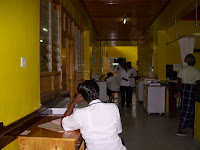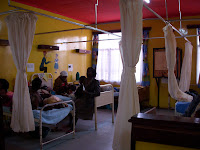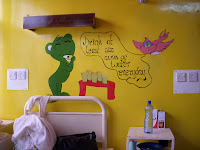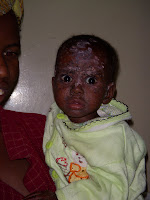My last week in Kenya was somewhat crazy. A lot of different things happened that I want to share with all of you, and rather than write one really long post, I've decided to split things up into shorter segments. So I'll start with my last day on the pediatric wards, which was definitely a day I will never forget.
My last day on the wards was last Thursday, and I had gone into the hospital that morn

ing expecting rounds to be short and sweet because we only had two patients. Our team was very small that day--just our intern, resident, one medical student, and me--which was a nice change of pace. As expected, we were done rounding by 930am, and I was ready to do some last minute 'chores' to wrap up my two months at Moi Hospital. What I didn't know was that something else was about to happen....something that I certainly had not planned for.
Just as we were close to being done rounding, a new patient was admitted to our ward. We saw a mother walk in with her 10 month old girl in her arms, who appeared to be pretty stable on first glance. As is typical, the nurse proceeded to get the new patient situated in a bed before we came over to see her. My resident had planned to fully assess the child with me once we were finished rounding on our last inpatient. However, that plan changed about two minutes after the child got to her bed, as the nurse came running over to us, saying that we needed to come see the baby.
When we got to the little girl, she was not breathing. She was lying lifeless on the bed.

We checked for a pulse, and when we found that she had none, the resident, intern, and I started CPR. It took a minute or so to get an ambu bag, but once we did, we found it hard to get any air into the baby's lungs. It seemed that she was full of secretions that were blocking her airway. We asked the nurse to quickly get us some suction, but as is the norm at MTRH, it took several minutes before a suction machine made it to us. By the time it arrived, it was too late. The baby had been without a heartbeat and without any oxygen for too long. Our resuscitation efforts had failed.
That was the first time I had lost a pediatric patient after actively participating in a rescucitation attempt, and I'm sure that I will never forget that day. We still don't know what happened to the little infant, but we suspect that she somehow aspirated after breast feeding. I

still maintain that we could have saved her if we had the right tools closer by, but that's something I will never know.
After we consoled the mother and walked away from the little girl's bed, the Kenyan medical student on my team turned to me and said something that struck me. He said, "I worked at Wishard [in Indianapolis] for 6 weeks and we had one death the entire time--and it was a big deal. Here, this type of thing happens multiple times a day, and it doesn't phase anyone." That particular medical student had spent part of his 5th year of medical school working at Wishard Hospital in Indianapolis as part of the IU-Kenya exchange program. Thus, he knew how things worked back home and how much it differs from Kenyan medicine. His comment is one that many Americans had made before, but to hear those words come from a Kenyan was different. He made

me realize that even though death is so widespread amongst the wards at MTRH, it does have an effect on the physicians and students there, which is not something I was sure of before that day.
As you can tell, my last day on the wards was not what I had anticipated. It definitely caught me off guard, but looking back, it was a great learning experience. It was humbling, to say the least, and I will always remember the way I felt that day.
*I've posted a few pictures of the pediatrcs ward for you to see. The last picture is one of a patient with chicken pox that was on our ward. He was adorable, but definitely had a bad case of the pox!!


